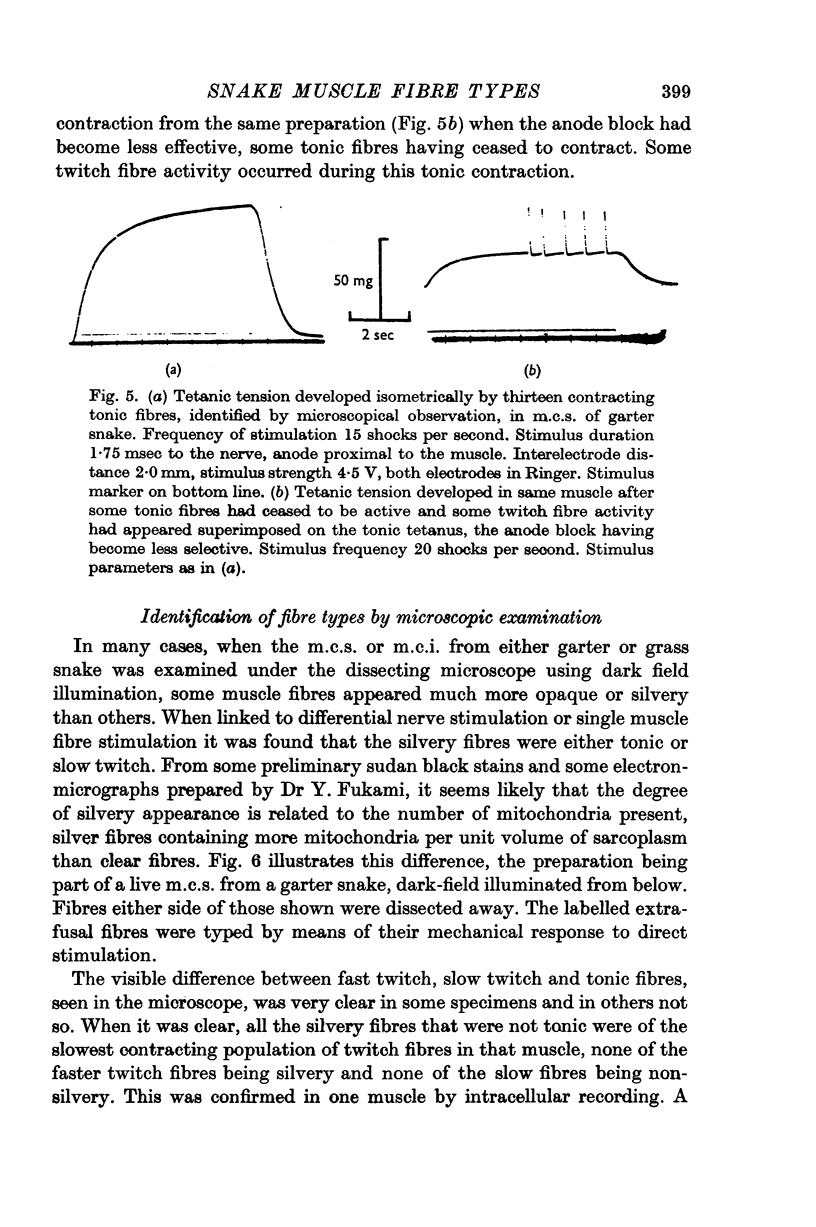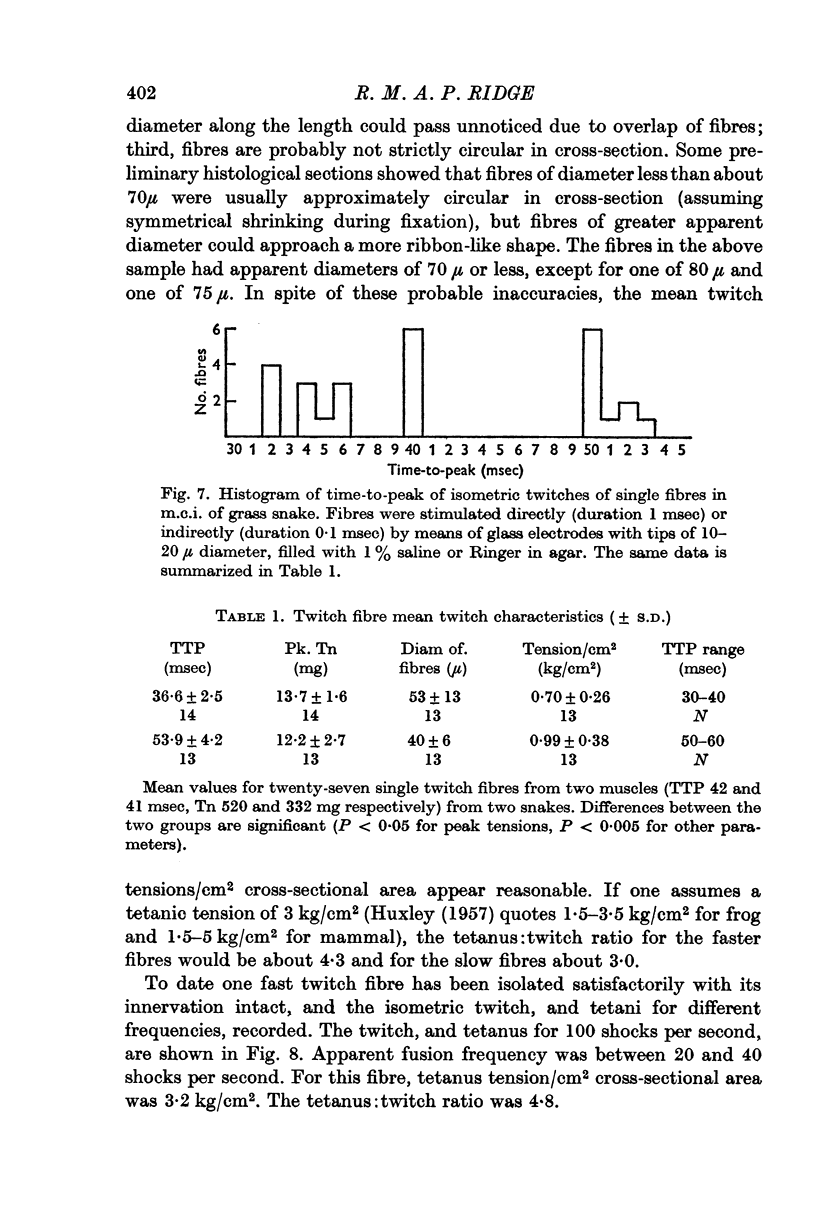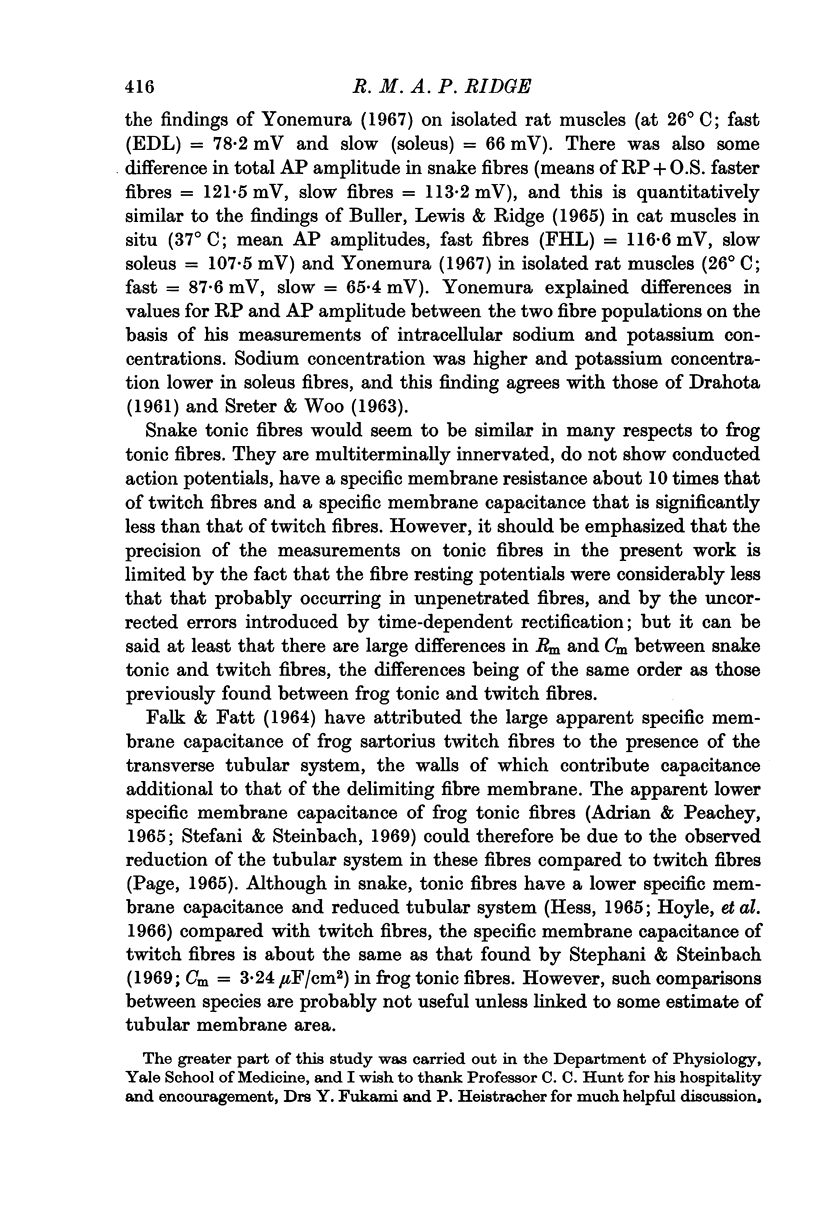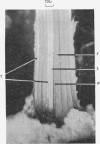Abstract
1. Tonic and twitch muscle fibres were identified physiologically in m. costocutanei superiores and inferiores of garter snakes and grass snakes.
2. Tonic fibres were multiterminally innervated and showed s.j.p.s in response to nerve stimulation. They did not show propagated A.P.s. They were innervated by motor axons with lower conduction velocities than those to twitch fibres, and often gave a contraction and developed tension in response to a single shock to the nerve. Intracellular square pulse analysis showed that Cm = 1 μF/cm2 and Rm = 40,000 Ω cm2.
3. Twitch fibres showed a conducted action potential in response to nerve stimulation, and focal, as opposed to diffuse, innervation. They showed a variety of isometric twitch contraction times (times-to-peak of about 30-65 msec). Groups of similar motor units contained fibres of approximately similar contraction times. Slow twitch (and tonic) fibres often appeared silvery under dark field illumination, while faster twitch fibres appeared clear. No difference in Cm, Rm or λ was found between faster and slow twitch fibres. Values were approximately 3-4 μF/cm2, 3000-4000 Ω cm2 and 2 mm respectively.
Full text
PDF

























Images in this article
Selected References
These references are in PubMed. This may not be the complete list of references from this article.
- ADRIAN R. H. The effect of internal and external potassium concentration on the membrane potential of frog muscle. J Physiol. 1956 Sep 27;133(3):631–658. doi: 10.1113/jphysiol.1956.sp005615. [DOI] [PMC free article] [PubMed] [Google Scholar]
- Adrian R. H., Peachey L. D. The membrane capacity of frog twitch and slow muscle fibres. J Physiol. 1965 Nov;181(2):324–336. doi: 10.1113/jphysiol.1965.sp007764. [DOI] [PMC free article] [PubMed] [Google Scholar]
- BOYD I. A., MARTIN A. R. Membrane constants of mammalian muscle fibres. J Physiol. 1959 Oct;147:450–457. doi: 10.1113/jphysiol.1959.sp006255. [DOI] [PMC free article] [PubMed] [Google Scholar]
- Barker D. L'innervation motrice du muscle strié des vertébrés. Actual Neurophysiol (Paris) 1968;8:23–71. [PubMed] [Google Scholar]
- FALK G., FATT P. LINEAR ELECTRICAL PROPERTIES OF STRIATED MUSCLE FIBRES OBSERVED WITH INTRACELLULAR ELECTRODES. Proc R Soc Lond B Biol Sci. 1964 Apr 14;160:69–123. doi: 10.1098/rspb.1964.0030. [DOI] [PubMed] [Google Scholar]
- FATT P., KATZ B. An analysis of the end-plate potential recorded with an intracellular electrode. J Physiol. 1951 Nov 28;115(3):320–370. doi: 10.1113/jphysiol.1951.sp004675. [DOI] [PMC free article] [PubMed] [Google Scholar]
- FEIN H. SOLID-STATE ELECTROMETERS WITH INPUT-CAPACITANCE NEUTRALIZATION. IEEE Trans Biomed Eng. 1964 Jan-Apr;11:13–18. doi: 10.1109/tbme.1964.4502292. [DOI] [PubMed] [Google Scholar]
- HUXLEY A. F. Muscle structure and theories of contraction. Prog Biophys Biophys Chem. 1957;7:255–318. [PubMed] [Google Scholar]
- Heistracher P., Hunt C. C. The relation of membrane changes ot contraction in twitch muscle fibres. J Physiol. 1969 May;201(3):589–611. doi: 10.1113/jphysiol.1969.sp008774. [DOI] [PMC free article] [PubMed] [Google Scholar]
- Hess A. The sarcoplasmic reticulum, the T system, and the motor terminals of slow and twitch muscle fibers in the garter snake. J Cell Biol. 1965 Aug;26(2):467–476. doi: 10.1083/jcb.26.2.467. [DOI] [PMC free article] [PubMed] [Google Scholar]
- Hess A. Vertebrate slow muscle fibers. Physiol Rev. 1970 Jan;50(1):40–62. doi: 10.1152/physrev.1970.50.1.40. [DOI] [PubMed] [Google Scholar]
- Hoyle G., McNeill P. A., Walcott B. Nature of invaginating tubules in Felderstruktur muscle fibers of the garter snake. J Cell Biol. 1966 Jul;30(1):197–201. doi: 10.1083/jcb.30.1.197. [DOI] [PMC free article] [PubMed] [Google Scholar]
- Hunt C. C., Wylie R. M. Responses of snake muscle spindles to stretch and intrafusal muscle fiber contraction. J Neurophysiol. 1970 Jan;33(1):1–8. doi: 10.1152/jn.1970.33.1.1. [DOI] [PubMed] [Google Scholar]
- KUFFLER S. W., VAUGHAN WILLIAMS E. M. Properties of the 'slow' skeletal muscles fibres of the frog. J Physiol. 1953 Aug;121(2):318–340. doi: 10.1113/jphysiol.1953.sp004949. [DOI] [PMC free article] [PubMed] [Google Scholar]
- KUFFLER S. W., VAUGHAN WILLIAMS E. M. Small-nerve junctional potentials; the distribution of small motor nerves to frog skeletal muscle, and the membrane characteristics of the fibres they innervate. J Physiol. 1953 Aug;121(2):289–317. doi: 10.1113/jphysiol.1953.sp004948. [DOI] [PMC free article] [PubMed] [Google Scholar]
- Kiyohara T., Sato M. Membrane constants of red and white muscle fibers in the rat. Jpn J Physiol. 1967 Dec 15;17(6):720–725. doi: 10.2170/jjphysiol.17.720. [DOI] [PubMed] [Google Scholar]
- Levine L. An electrophysiological study of chelonian skeletal muscle. J Physiol. 1966 Apr;183(3):683–713. doi: 10.1113/jphysiol.1966.sp007893. [DOI] [PMC free article] [PubMed] [Google Scholar]
- Page S. G. A comparison of the fine structures of frog slow and twitch muscle fibers. J Cell Biol. 1965 Aug;26(2):477–497. doi: 10.1083/jcb.26.2.477. [DOI] [PMC free article] [PubMed] [Google Scholar]
- Proske U., Vaughan P. Histological and electrophysiological investigation of lizard skeletal muscle. J Physiol. 1968 Dec;199(3):495–509. doi: 10.1113/jphysiol.1968.sp008665. [DOI] [PMC free article] [PubMed] [Google Scholar]
- SRETER F. A., WOO G. CELL WATER, SODIUM, AND POTASSIUM IN RED AND WHITE MAMMALIAN MUSCLES. Am J Physiol. 1963 Dec;205:1290–1294. doi: 10.1152/ajplegacy.1963.205.6.1290. [DOI] [PubMed] [Google Scholar]
- Stefani E., Steinbach A. B. Resting potential and electrical properties of frog slow muscle fibres. Effect of different external solutions. J Physiol. 1969 Aug;203(2):383–401. doi: 10.1113/jphysiol.1969.sp008869. [DOI] [PMC free article] [PubMed] [Google Scholar]
- Yonemura K. Resting and action potentials in red and white muscles of the rat. Jpn J Physiol. 1967 Dec 15;17(6):708–719. doi: 10.2170/jjphysiol.17.708. [DOI] [PubMed] [Google Scholar]



